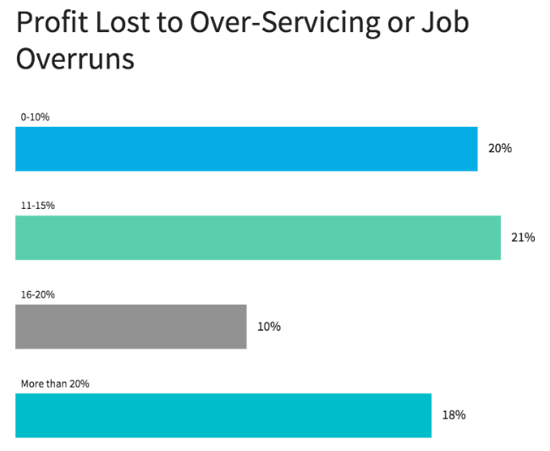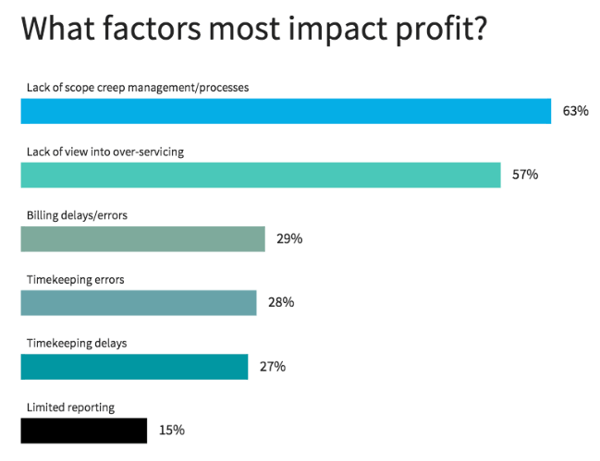

You give and give and give, hoping the client will see all those extra hours, late nights, and value-adds as a sign of your commitment.
But all it does is make the client question the cost of your services. How valuable is the relationship if the agency consistently gives away its time for free?
In addition, your team members are stressed. They’re spending so much time doing work that is outside the scope of the project for one client that they can barely keep up with the client work your agency is actually being paid for. Capacity levels are never correct, so everyone is overworked. And because of the loss of profits, you have to skimp on pay increases this year.
This is the definition of a bad business practice.
Yet it's a common problem: According to a report by the Society of Digital Agencies on the State of Agency Workflow Management, 49% of agencies reported a profit loss of 11% or more due to overservicing.

Respondents indicated that a lack of scope creep management and processes had the most impact on reducing profits, while a lack of view into overservicing was the second most cited reason for a loss in profits.

Research done by The Agency Works found that 66% of agencies in the U.K. are concerned with overservicing. Their second biggest concern was profitability. The problem is you can’t solve the latter without first fixing overservicing.
While you believe that doing extra work will extend the life of the client relationship or engender good will -- and it might -- overservicing should not be the norm, and it can’t be done at the cost of the health of your business.
Here are a few ways to stop doing work you’re not getting paid for.
7 Ways to Prevent Overservicing
1) Set Up an Alert System
The first step is getting real-time visibility into a project’s progress, costs, and timeline, which can be monitored with a project management tool. With this information, you can notify the team when a client is at risk of overservicing. You need to consciously determine whether or not doing out of scope work for a client is the right approach, rather than being reactive to the situation.
2) Analyze Past Projects
Overservicing could be a widespread problem, or it could be the result of taking on a client that doesn’t align with your ideal client profile. It could also be correlated with a specific type of project such as a web redesign, which should prompt you to reconsider the initial scoping process and management of these projects. What problems typically cause projects to go out of scope, and can you create a process to prevent this? In addition, overservicing might be tied to one or a few account managers' clients, revealing who needs more training and education on the team.
3) Create a System for Changing Scopes of Work
If you know that a project is going beyond the scope, you can address the issue with the client by expanding the scope and the budget or by resetting expectations about what can actually be accomplished. It should be clear what the original project included and what it didn’t -- if you properly scoped the project in the first place -- so any additional requests require a change order and an additional fee.
4) Be Upfront About Changing Scopes
Before the prospect signs on the dotted line, you should be upfront about your process for expanding scopes of work. Explain that scoping a project with many unknowns isn't a perfect science and provide examples of changing scopes from past projects. Give budget ranges that indicate the additional costs that can occur if a project gets out of hand, but also reassure them that you will be honest and as proactive as possible about notifying them when you think a project’s budget needs to be adjusted.
5) Get Good at Project Scoping
Train your employees and create processes that help them to create an accurate project scope and manage the project to stay within those defined boundaries. Teach them to ask the right questions or develop question guides for various different types of projects. Emphasize using clear and detailed communication to prevent missteps from miscommunication.
6) Value Your Work
When you give your work away for free or at a reduced price, you are training your clients, and worse, your team members to devalue the work you do. While it might only take you two or three hours to create that additional landing page or banner ad, that time and the resulting output is of value and should be treated that way. If you do write off services, be sure to highlight this to the client, showcasing the number of hours and the original value of that time on the invoice or monthly report -- this also helps with tracking overbudget projects.
7) Create Incentives for Achieving Profitability
Reward internal teams that are able to complete projects that are profitable for the agency. This is a group effort, and you should recognize those that are able to balance the needs of the client with those of the agency. Use a time tracking tool to determine the actual amount of time needed to complete projects, and track the utilization rate of each employee to better understand the efficiency of your team members.









